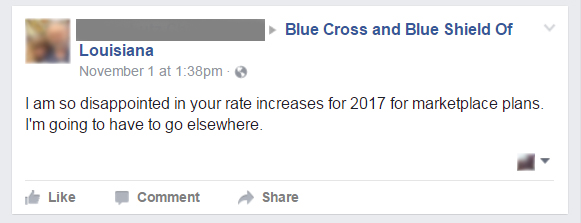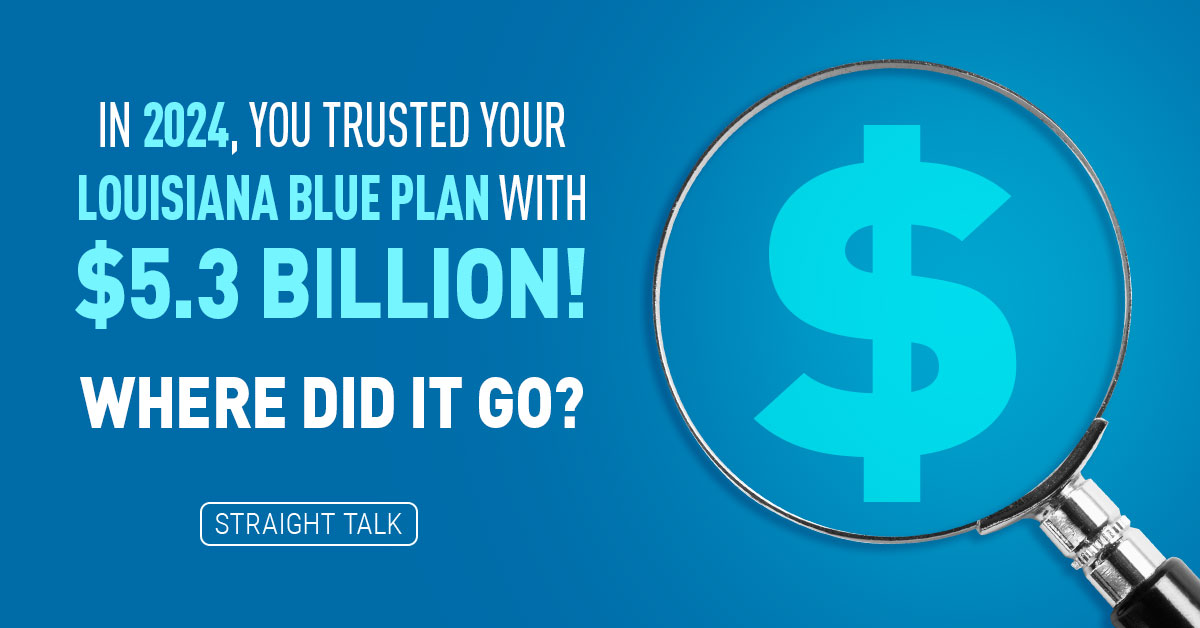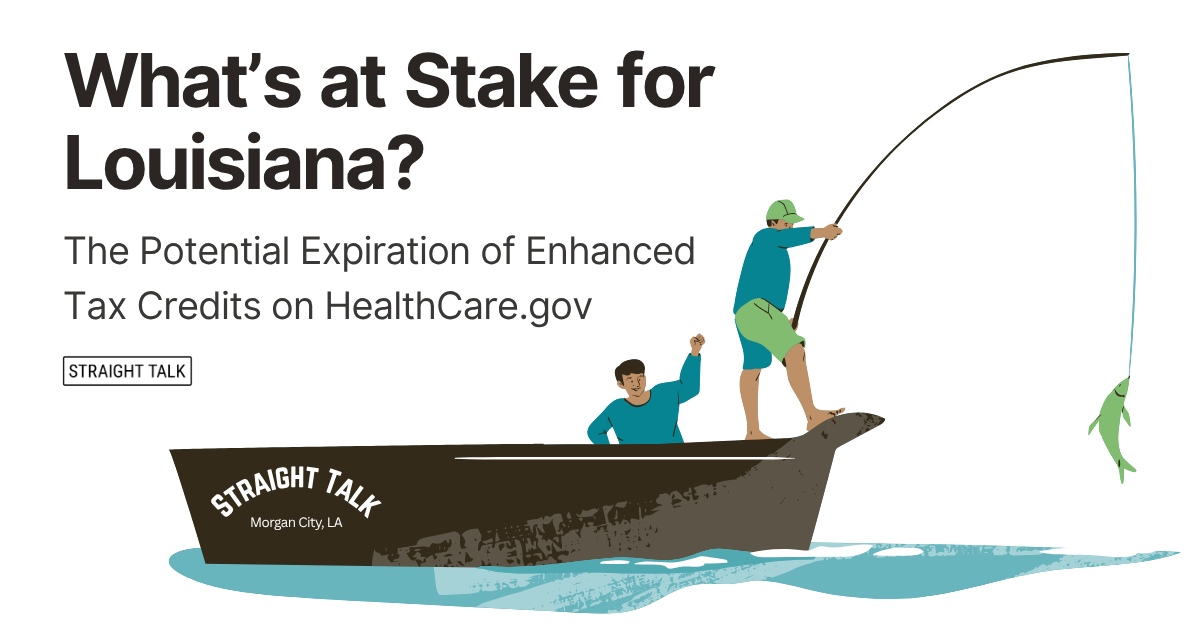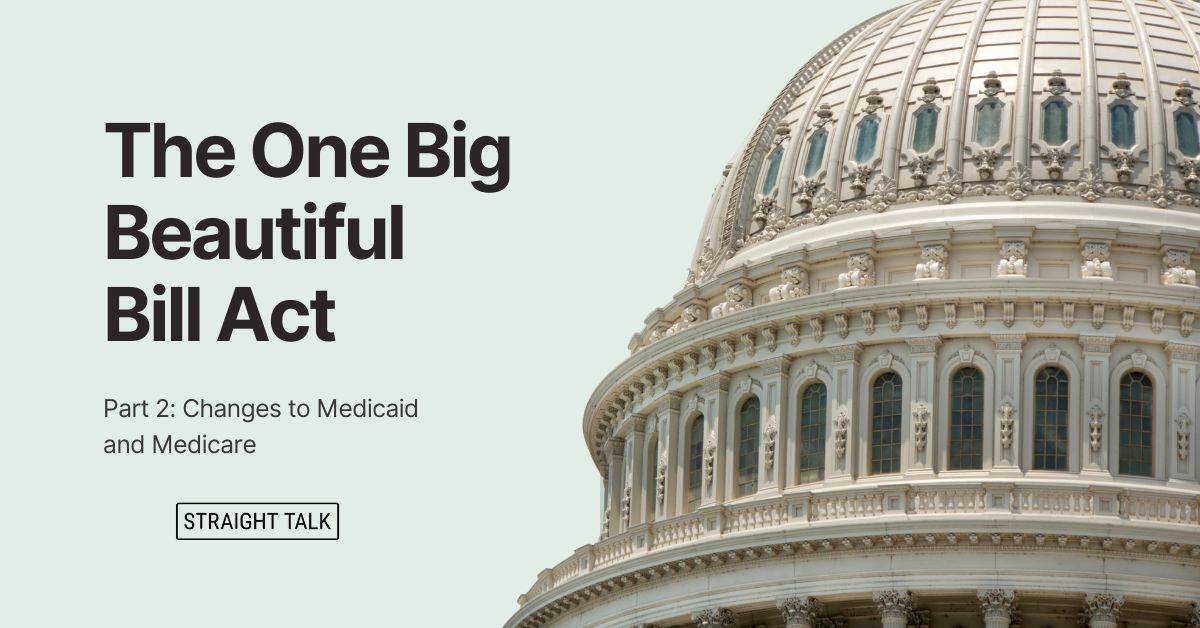


Open Enrollment is upon us, social media has come alive, and I think it is CRITICAL to our mission here at Blue Cross and Blue Shield of Louisiana (“To improve the health and lives of all Louisianians”) that we are as transparent as possible with you about why rates are going up in 2017.
Since I’m going to talk to you about the individual health insurance market (people who buy their own coverage and don’t get it through work) for 2017 today, I’m going to apologize in advance. If you’ve gotten your 2017 rate notices, you already know prices have skyrocketed, and there’s no way I’m going to sugarcoat this for you. As Blue Cross customers and fellow Louisianians, you deserve all the truth there is to tell. So here it is, in plain English — why your rates are going up so much in 2017:
Blue Cross didn’t raise rates fast enough in 2014-15. The newly covered population the healthcare law brought in uses healthcare much more than we could ever have imagined. So now we are playing catch-up.
Not what you wanted to hear? Of course not! But reality is a tough row to hoe sometimes, and facts are stubborn things.
The federal government, in converting the individual market from one where insurers were allowed to charge people appropriate rates based on their individual health conditions to one where everybody gets in, no questions asked, has caused unimaginable disruptions in costs and pricing.
“Now there is a regulation that has more holes than a screen door and allows 29 different reasons why you don’t have to pay the fine for not having coverage.”
To make matters worse, the parts of the healthcare law that were supposed to drive the young and healthy into the risk pool and keep costs down have been ignored and abused by a federal administration out of touch with what is happening to the average Louisiana customer. You thought the flood response from Washington, D.C., was weak? We’ve been pleading for relief on these issues for three years straight with no response.
But Mike, where are the young people?
Our current risk pool of individual customers is, on average, 44 years old, while Louisiana’s population has an average age of 34. Clearly, the young and healthy are under-represented in our risk pools. Why?
Prices for young folks are too high, relative to older folks. The average 64-year-old in our individual risk pool uses around 700% of the healthcare the average 21-year-old uses. But a poorly designed federal law forces us to charge the 64-year-old only three times more. This means the 21-year-old’s rates are 75% too high. So, young folks look at the prices and stay away. This makes the whole pool older, sicker and way, way more expensive than ever.
“Our “special” enrollees use 400% as much healthcare as everyone else, and do it in only five months on average before they stop paying premiums. They are “jumping” in, getting care and then “dumping” coverage as quickly as they can, enabled by federal regulations that leak like a 100-year-old cypress pirogue that has just hit the water.”
But Mike, how can the young folks stay away? There’s a law that says everyone HAS to have health insurance!
Well, there used to be. Now there is a regulation that has more holes than a screen door and allows 29 different reasons why you don’t have to pay the fine for not having coverage. People have even started bragging in the media about how they are avoiding the penalty. The feds have made this situation worse every year by giving in to lobbying and allowing the number of exemptions to grow from three (in 2014) to 29 today. The fine, as you might imagine, motivates no one.
But Mike! People can’t buy insurance outside of Open Enrollment (November-January). What happens if they don’t buy coverage and then get sick in July?
Those purchases outside of Open Enrollment Periods are subject to something called Special Enrollment triggers. And by the way, there are 10 or 12 of these, NONE of which require any proof up front. In other words, there is no documentation required, and people are smart — they have figured this stuff out. The reality is the feds have done such a lousy job of policing special enrollment periods that people are waiting to enroll until after they get sick. You can see that once insurance gets more expensive, their incentive to wait is enhanced, and because of a weak and leaky process, more and more young and healthy people are waiting. This is driving costs up for everyone.
Our “special” enrollees use 400% as much healthcare as everyone else, and do it in only five months on average before they stop paying premiums. They are “jumping” in, getting care and then “dumping” coverage as quickly as they can, enabled by federal regulations that leak like a 100-year-old cypress pirogue that has just hit the water. And we beg and we plead, but we get no relief on this from the federal agencies that run this whole shebang.
But back to my original point: Why didn’t we charge more back in 2014 and 2015?
“There is an expectation in Washington, D.C., that we and other insurers will just raise our rates until break-even occurs.”
That’s our mistake. Even MY mistake, as I was in on the computations. We trusted the feds on two critical points, and they have let us down on both. Sorry if this sounds like a broken record, but I’m a big believer in people taking responsibility when they screw up. I make my kids do it, I expect my company to do it and I certainly expect my federal government in Washington, D.C., to acknowledge and fix the things they break. They are doing neither in this case.
In summer 2013, Blue Cross got federal estimates and data that were supposed to help us determine how much to charge all these new enrollees. We looked over the cost estimates and decided they were wrong because they were too low. And we went about 20% higher than that. Sadly, the real numbers have consistently come in with claims costs 80% higher than that original estimate. So we started out with rates that were too low. Didn’t feel low at the time, did they? Nope, not to me, either.
Second, the feds promised us financial relief as a carrot to get us to participate in this new and scary market. They said there would be programs in place to level the playing field, so if we absorbed more than our share of sick folks, there would be money available to help soothe our losses. “Risk Corridor Programs” was the technical term.
After two years, it was clear Blue Cross had absorbed more than our share of the new market, and the Risk Corridor/Risk Adjustment program should have paid us around $100 million. Thanks to Congress, it is clear they are never going to pay this bill (we’ve gotten 12% of the money so far), and so we are being forced to charge our customers higher premiums to account for the difference and cover our customers’ healthcare claims. This behavior actually drove the Louisiana Co-Op insurance plan out of business. Luckily, Blue Cross had enough money in the bank to absorb this, but we have to figure out how to make the individual market more stable, at least break-even.
There is an expectation in Washington, D.C., that we and other insurers will just raise our rates until break-even occurs. On our side, I can report we spent more premium dollars directly on healthcare (87%) in 2015 than ever before. So, we are managing our overhead strongly and forcefully to make sure as much of your money as possible pays for healthcare. So far, it still hasn’t been enough.
In my next post, I’ll talk about why deductibles, coinsurance and copays keep going up. This is yet another interesting story in the puzzle that is healthcare.
The battle continues. The exchange at www.healthcare.gov opened for business on Nov. 1, 2016, and we know people will need to go shopping for the best deal. Nothing but my best wishes, and good luck to you all!





So I understand that the ACA plans being sold by Blue Cross Blue Shield LA have been a disaster. I don’t think the government requires carriers to sell ACA plans. Why would BCBS continue to sell these plans if they are so terrible? Seems like common sense that if you quit selling them other customers won’t have to continue shouldering the losses for ACA members through outrageous premiums. As you admitted, it looks like BCBS made some bad business decisions and now are forcing customers to pay for your mistakes. Even crazier, BCBS is still willfully participating in a business segment that they know is a loser.